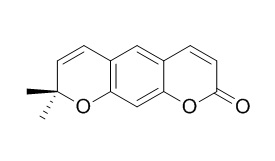Xanthyletin
Xanthyletin has anti-inflammatory, anti-tumor and anti-bacterial activities, it also inhibits symbiotic fungus cultivated by leaf-cutting ants. Xanthyletin exhibits potent inhibition (IC50 values ≤ 4.79 ug/mL) of superoxide anion generation by human nutrophils in response to N-formyl-L-methionyl-L-leucyl-L-phenylalanine/cytochalasin B (fMLP/CB); it inhibits fMLP/CB-induced elastase release with IC50 values ≤ 5.48 ug/mL.
Inquire / Order:
manager@chemfaces.com
Technical Inquiries:
service@chemfaces.com
Tel:
+86-27-84237783
Fax:
+86-27-84254680
Address:
1 Building, No. 83, CheCheng Rd., Wuhan Economic and Technological Development Zone, Wuhan, Hubei 430056, PRC
Providing storage is as stated on the product vial and the vial is kept tightly sealed, the product can be stored for up to
24 months(2-8C).
Wherever possible, you should prepare and use solutions on the same day. However, if you need to make up stock solutions in advance, we recommend that you store the solution as aliquots in tightly sealed vials at -20C. Generally, these will be useable for up to two weeks. Before use, and prior to opening the vial we recommend that you allow your product to equilibrate to room temperature for at least 1 hour.
Need more advice on solubility, usage and handling? Please email to: service@chemfaces.com
The packaging of the product may have turned upside down during transportation, resulting in the natural compounds adhering to the neck or cap of the vial. take the vial out of its packaging and gently shake to let the compounds fall to the bottom of the vial. for liquid products, centrifuge at 200-500 RPM to gather the liquid at the bottom of the vial. try to avoid loss or contamination during handling.
Food Chem.2019, 290:286-294
Genes (Basel).2021, 12(7):1024.
Molecules.2019, 24(6):E1155
Nutraceuticals2022, 2(3),150-161
Fermentation2023, 9(10), 889
Environ Toxicol.2023, 38(5):1174-1184.
ACS Pharmacol Transl Sci.2024, 7(2):395-405.
Pharmacia2024, 71:1-9.
Current Topics in Nutraceutical Research2021, 19(1),p90-105.
Int J Mol Sci.2024, 25(2):764.
Related and Featured Products
Int J Mol Sci. 2013 Nov 13;14(11):22395-408.
New benzo[c]phenanthridine and benzenoid derivatives, and other constituents from Zanthoxylum ailanthoides: Effects on neutrophil pro-inflammatory responses.[Pubmed:
24232457 ]
METHODS AND RESULTS:
A new benzo[c]phenanthridine, oxynorchelerythrine (1), and two new benzenoid derivatives, methyl 4-(2-hydroxy-4-methoxy-3-methyl-4-oxobutoxy)benzoate (2) and (E)-methyl 4-(4-((Z)-3-methoxy-3-oxoprop-1-enyl)phenoxy)-2-methylbut-2-enoate (3), have been isolated from the twigs of Zanthoxylum ailanthoides, together with 11 known compounds (4-14). The structures of these new compounds were determined through spectroscopic and MS analyses.
CONCLUSIONS:
Among the isolated compounds, decarine (4), (-)-syringaresinol (6), (+)-episesamin (8), glaberide I (9), (-)-dihydrocubebin (10), and Xanthyletin (11) exhibited potent inhibition (IC50 values ≤ 4.79 μg/mL) of superoxide anion generation by human nutrophils in response to N-formyl-L-methionyl-L-leucyl-L-phenylalanine/cytochalasin B (fMLP/CB). Compounds 4, 8, and 11 also inhibited fMLP/CB-induced elastase release with IC50 values ≤ 5.48 μg/mL.
Chem Pharm Bull (Tokyo). 2010 Jan;58(1):61-5.
Anti-inflammatory principles from the stem and root barks of Citrus medica.[Pubmed:
20045968]
METHODS AND RESULTS:
Bioassay-guided investigation of the anti-inflammatory principles from the stem and root barks of Citrus medica L. var. sarcodactylis SWINGLE has led to the isolation of a new coumarin, namely citrumedin-B (1) and thirty known compounds.
The anti-inflammatory components were Xanthyletin (2), nordentatin (3), atalantoflavon (4) and lonchocarpol A (5) which displayed potent nitric oxide (NO)-reducing activity in microglial cells. The structure of this new compound was completely elucidated using a combination of 2D NMR techniques (correlation spectroscopy (COSY), nuclear Overhauser effect spectroscopy (NOESY), heteronuclear multiple quantum coherence (HMQC) and heteronuclear multiple bond connectivity (HMBC)) and HR-electrospray ionization (ESI)-MS analyses. The known compounds were identified by comparison of their spectroscopic and physical data with those reported in the literature.
CONCLUSIONS:
These results can be inferred from the treatment of allergic response and inflammatory properties of Citrus medica L. var. sarcodactylis SWINGLE in traditional Chinese medicine.
Nutr Cancer. 2012;64(2):255-66.
The butanol fraction of guava (Psidium cattleianum Sabine) leaf extract suppresses MMP-2 and MMP-9 expression and activity through the suppression of the ERK1/2 MAPK signaling pathway.[Pubmed:
22211962 ]
The leaf extract of guava (Psidium cattleianum Sabine) has traditionally been used for the treatment of diarrhea and diabetes in East Asia and other countries. Recently, the leaf extract has been employed in the therapy of cancer, bacterial infections, and inflammation in experimental models. However, the exact mechanisms of how guava leaf extract inhibits tumor metastasis and invasion are still unknown.
METHODS AND RESULTS:
In the present study, we investigated in detail the molecular mechanism(s) responsible for the potential antimetastatic and antiinvasive effects of the butanol fraction of guava leaf extract (GBF). Interestingly, we observed for the first time that GBF suppressed both matrix metalloproteinases (MMP)-9 and MMP-2 expression and activity in part through the downregulation of the ERK1/2 activation in lung cancer cells. Also, importantly, the major components of the GBF were identified as d-glucuronic acid, quercetin 3-glucuronide, loganin, and Xanthyletin by LC-ESI-MS/MS.
CONCLUSIONS:
Collectively, our data indicate that the guava leaf could reduce the metastasis of lung cancer cells and therefore suggest that it could be advantageously used to control the metastatic process.
J Chromatogr A. 2009 May 8;1216(19):4307-12.
Isolation of xanthyletin, an inhibitor of ants' symbiotic fungus, by high-speed counter-current chromatography.[Pubmed:
19296958 ]
Xanthyletin, an inhibitor of symbiotic fungus (Leucoagaricus gongylophorus) of leaf-cutting ant (Atta sexdens rubropilosa), as well as suberosin, seselin and xanthoxyletin were isolated from Citrus sinensis grafted on Citrus limonia.
METHODS AND RESULTS:
A two-phase solvent system composed of hexane/ethanol/acetonitrile/water (10:8:1:1, v/v) was used for the high-speed counter-current chromatographic isolation of Xanthyletin with high yield and over 99% purity as determined by liquid and gas chromatography with mass spectrometry detection. Identifications were performed by UV spectra, IR spectra, (1)H NMR and (13)C NMR.



